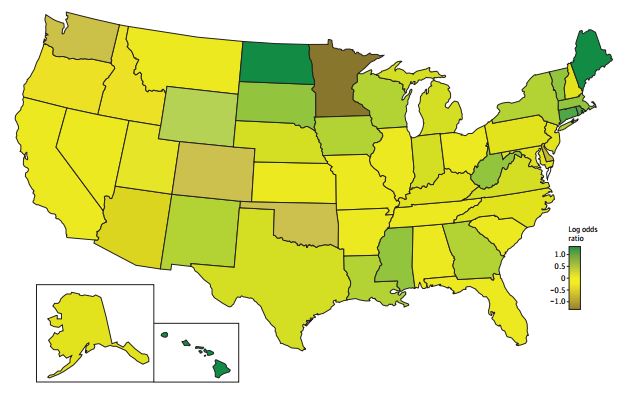The 4/20 Effect: Pot Celebration Day Tied to Rise in Fatal Crashes

It's the day to celebrate for marijuana enthusiasts: April 20, or 4/20. Each year, thousands of pot supporters mark the "high" holiday by lighting up at precisely 4:20 p.m. But the popular celebration may come with a buzzkill: an increase in the risk of fatal car crashes, a new study finds.
The study analyzed data on fatal car crashes in the United States over a 25-year period. The researchers homed in on the number of drivers who were involved in fatal car crashes on April 20 between 4:20 p.m and 11:59 pm. They compared this with the number of drivers involved in fatal car crashes on April 13 and April 27 (which are a week before and a week after April 20).
The researchers found that, in total, there were 1,369 drivers involved in fatal car crashes after 4:20 p.m. on April 20, compared with 2,453 drivers involved in fatal crashes during the same time period on April 13 and April 27 combined. That corresponds to 7.1 fatal crashes per hour on April 20, versus 6.4 fatal crashes per hour on April 13 and April 27.
Overall, there was a 12 percent increase in the risk of fatal crashes on April 20, compared with the other days, according to the study, published today (Feb. 12) in the journal JAMA Internal Medicine. The risk was highest among drivers younger than 21, who saw a 38 percent increase in their risk. The greatest increases in the number of fatal crashes was seen in New York, Texas and Georgia, the researchers said. There was no increase in fatal crashes before 4:20 p.m. on April 20. [25 Odd Facts About Marijuana]
Interestingly, the study found that some states where recreational marijuana is legal, including Colorado and Washington, had a decreased risk of fatal crashes on April 20, compared with April 13 and April 27.
One reason for this could be that these states already have a high level of marijuana consumption to begin with, said Dr. John Staples, lead author of the study and a clinical assistant professor of medicine at the University of British Columbia's Centre for Health Evaluation and Outcome Sciences.
"It is possible that some states with high base rates of cannabis consumption exhibit little increase in consumption on 4/20," Staples told Live Science. In addition, the study includes data for the last 25 years, and so it includes a period of time well before recreational marijuana became legal.
Get the world’s most fascinating discoveries delivered straight to your inbox.
A longtime celebration — and public health risk
The 4/20 celebration was first popularized in 1991, and since then, events in cities such as Denver, San Francisco and Vancouver, Canada, have grown to include tens of thousands of people, the researchers said.
Some studies have found that driving after using marijuana leads to decreases in reaction times; and other studies have linked marijuana intoxication with car crashes. It's not known how common it is for people to drive after smoking pot, but one study of U.S. college freshmen at two large public universities found that 44 percent of marijuana users said they drove soon after using marijuana within the last month. In addition, a 2017 survey on cannabis use in Canada found that only half of marijuana users thought that the drug affected driving.
The researchers said that policymakers may want to consider these risks in places where marijuana is legal, and pay particular attention to strategies to curtail driving under the influence or marijuana.
"One-fifth of Americans now live in states that have legalized recreational cannabis, and legalization is set to occur for all Canadians in July 2018," Staples said in a statement. "We hope that legalization doesn't lead to more people driving while high."
Previous studies have found that other events are linked with an increase in driving fatalities. A 2003 study found that there was a 41 percent increase in traffic fatalities after Super Bowl Sunday, compared with other Sundays.
Given that far fewer people likely celebrate 4/20 compared with the number of people who watch the Super Bowl, the risk seen in the new study (a 12 percent increase) is comparable in magnitude to the risk seen on Super Bowl Sunday, Staples said.
If fewer than 10 percent of Americans drive while high on April 20, the researchers estimate that drug use at 4/20 celebrations more than doubles the risk of a fatal crash, said study co-author Dr. Donald Redelmeier, a professor at the University of Toronto.
The researchers hope that their results encourage authorities to advocate for safer travel options on 4/20, such as public transit, rideshares, taxis and designated drivers. Cannabis retailers and 4/20 event organizations could also help by warning users not to drive while high, they said. "Our findings should remind policymakers that traffic injuries are a preventable disease," Staples said. Thoughtful policies can eliminate drugged driving and keep our roads safe," he said.
Original article on Live Science.

Rachael is a Live Science contributor, and was a former channel editor and senior writer for Live Science between 2010 and 2022. She has a master's degree in journalism from New York University's Science, Health and Environmental Reporting Program. She also holds a B.S. in molecular biology and an M.S. in biology from the University of California, San Diego. Her work has appeared in Scienceline, The Washington Post and Scientific American.
 Live Science Plus
Live Science Plus






